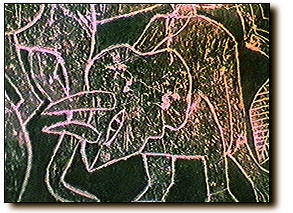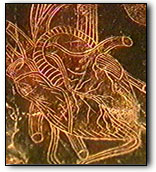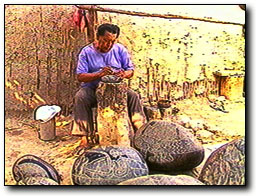J U R A S S I C A R T
|
Sophia Melewska is a Geomorphologist who was commissioned to investigate the rocks, summarize their content, and comment on their authenticity. After studying the collection of Ica stones, Dr. Melewska said that she was in a state of "intellectual shock." The art that surrounds the entire rock face shows evidence of an advanced civilization that knew about surgery, the history of man's past, and the Earth's evolution. But how? Melewska is one of the scientists now trying to direct the attention of professional research toward this mystery. But her battle is a tough one.
In their video production, Jurassic Art, the producers again sent Neil Steede to examine this phenomenon. Neil, as was suggested with the Julesrod report, is unbiased. He travels the globe looking at stones and listening to all sorts of claims and stories. Some stories are blatantly fake, while others seem shockingly real and genuinely perplexing. Neil examined the varnish on the stones but was not able to guess at the date. They looked old, but exactly how old was old? In cases where no organic material can be dated, the setting and strata where the objects are found can often give a clue to their age. Unfortunately, since these stones were revealed by accidental erosion, their original resting place is not known. Perhaps there were other ways of determining their age.
If these stones are to be taken at face value, the time frame of our past history is askew. Either humans were able to remember dinosaurs and medical procedures as part of their history, or some species of dinosaur lived to fairly recent times. Of course, dismissing them as a hoax is the easiest way to avoid this brain teaser. But since the stones seem to be associated with a culture possessing highly developed engineering and mathematical aptitudes, it is not an impossibility that such civilization might also have had knowledge of Earth's history and human evolution. Could dinosaurs have lived until recent times? There is some evidence for this. Certain species of animals, thought to be extinct, have been found frozen and preserved. Mastodons (a type of hairy elephant) have been found in Siberian ice. These animals could have survived through the last ice age, some 13,000 years ago. Their bodies were so intact that, upon autopsy, fresh daffodils and sweet grass was found undigested in their stomachs. Unfortunately the stones do not show Mastodons, and no frozen dinosaurs have yet been found. So the question to be answered is this: If there was an advanced civilization in South America thousands of years ago, why did it vanish? Who were they? How did they know of dinosaurs and stone masonry? These questions are brought to clarity in the video, Jurassic Art. Surprisingly, a sane answer is available and will be the subject of the next chapter in the amazing history of this third rock from the Sun. Also, if you enjoy this type of archaeological story, check out The Picket Wire Canyon People-- a recent Viewzone expedition to an amazing find of rare petroglyphs in Southeast Colorado. |

Other related articles on this site:
.
.
.
.
.
If you have a suggestion or history related article to submit, send it to:
Editor/viewzone.com
myristicin@hotmail.com
 One could easily attribute these stones to any pre-Columbian civilization were it not for the uncanny and unmistakable pictures of dinosaurs, humans flying on Pterodactyls and vivid scenes of human heart transplants and continental world maps.
One could easily attribute these stones to any pre-Columbian civilization were it not for the uncanny and unmistakable pictures of dinosaurs, humans flying on Pterodactyls and vivid scenes of human heart transplants and continental world maps. Unlike clay figurines that have organic material (i.e. straw) in their composition, there are no organic materials in plain old rock that will tell anything of its age. Traditional radiocarbon dating techniques rely upon organic material (that was once alive) to determine age. The surface of these rocks, however, has a varnish that is the result of bacteria and minute organisms which have adhered to the surface. A good black varnish or patina will take thousands of years to discolor and coat each stone. Etching these rocks would have removed the existing varnish, revealing the bare rock. Since these rocks have developed additional varnish in the grooves, it seems likely that they have were carved a long time ago. But how long?
Unlike clay figurines that have organic material (i.e. straw) in their composition, there are no organic materials in plain old rock that will tell anything of its age. Traditional radiocarbon dating techniques rely upon organic material (that was once alive) to determine age. The surface of these rocks, however, has a varnish that is the result of bacteria and minute organisms which have adhered to the surface. A good black varnish or patina will take thousands of years to discolor and coat each stone. Etching these rocks would have removed the existing varnish, revealing the bare rock. Since these rocks have developed additional varnish in the grooves, it seems likely that they have were carved a long time ago. But how long? Acting on a rumor, Steede traveled to a nearby village where he met a local man who was in the process of carving similar stones for tourists and anyone else that could be duped into believing that they had a piece of antiquity. The rumors of Dr. Cabrera's collection have brought tourists to the area, seeking what they are assured are the "real stones." Steede found that the artist managed to emulate the style on the Ica stones, but his technique was not quite as good. Moreover, the tell-tale varnish was absent from his grooves. Despite this, skeptics point to these reproductions as proof of a hoax, and dismiss any serious study of the original collection which is still maintained by Dr. Cabrera. And if reproductions were not enough to cast doubt on the age of the Ica stones, their fantastic images of extinct animals and flying humans inhibit any serious scholar from taking a second look at the phenomenon.
Acting on a rumor, Steede traveled to a nearby village where he met a local man who was in the process of carving similar stones for tourists and anyone else that could be duped into believing that they had a piece of antiquity. The rumors of Dr. Cabrera's collection have brought tourists to the area, seeking what they are assured are the "real stones." Steede found that the artist managed to emulate the style on the Ica stones, but his technique was not quite as good. Moreover, the tell-tale varnish was absent from his grooves. Despite this, skeptics point to these reproductions as proof of a hoax, and dismiss any serious study of the original collection which is still maintained by Dr. Cabrera. And if reproductions were not enough to cast doubt on the age of the Ica stones, their fantastic images of extinct animals and flying humans inhibit any serious scholar from taking a second look at the phenomenon.